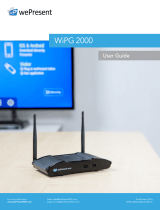
Barco | wePresent
P 16 / 25
MirrorOp Device Discovery (SSDP)
No matter what model of wePresent receiver device you use, MirrorOp Sender can automatically
discover any receiver device that resides on the same subnet as the sender device via the
proprietary discovery protocol (for WiPG-1000/ WiPG-1600W/ WiCS-2100) or mDNS (for WiCS-
2100). Moreover, MirrorOp Sender can also perform auto device discovery across subnets via
SSDP if: (a) the wePresent receiver device has SSDP (Simple Service Discovery Protocol) support
and; (b) IGMP (Internet Group Management Protocol) and PIM (Protocol Independent Multicast)
are enabled in your network environment. [Specific instructions on how to do this vary depending
on the exact brand and model of your network equipment. For assistance, please contact your
network equipment supplier.]
Note: SSDP is supported by two current wePresent models, namely WiPG-1600W and WiCS-2100.
The definition of “auto device discovery across subnets (via SSDP)” here is as follows: (a)
MirrorOp Sender can automatically discover (wePresent) receiver devices located on adjacent
subnets within an enterprise or school network; (b) The maximum number of adjacent subnets is
4; Namely, the SSDP multicast packet can be forwarded through no more than 3 routers (TTL =
4).
Receiver 1-2 can be discovered by MirrorOp Sender via the proprietary discovery protocol or mDNS
Receiver 1-9 can be discovered by MirrorOp Sender via SSDP.
Receiver 10-11 cannot be discovered by MirrorOp Sender as the SSDP multicast packet cannot be forwarded through more
than 3 routers.























